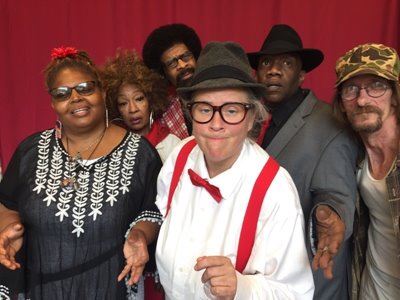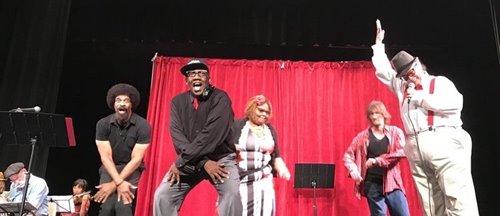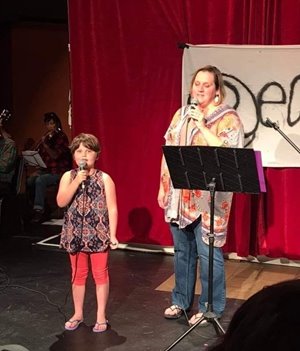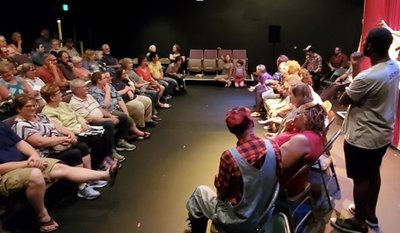Stories bring community together. Southwest Minnesota Housing Partnership (SMHP) learned this years ago, and has used storytelling and the arts to educate and share experiences of the wide variety of people who live in Worthington, Marshall, Wilmer and points between.
 The stories culminated in two productions in recent years, both staged before the pandemic began. One brought together immigrants and long-time prairie residents, wedding their commonalities. More recently, Placebase Productions, which had a residency with SMHP, researched the stories of those who had experienced homelessness. The conversations resulted in "A Prairie Homeless Companion," named for the Minnesota radio institution and performed by zAmya, a theater company composed of actors who have experienced housing insecurity.
The stories culminated in two productions in recent years, both staged before the pandemic began. One brought together immigrants and long-time prairie residents, wedding their commonalities. More recently, Placebase Productions, which had a residency with SMHP, researched the stories of those who had experienced homelessness. The conversations resulted in "A Prairie Homeless Companion," named for the Minnesota radio institution and performed by zAmya, a theater company composed of actors who have experienced housing insecurity.
This month, the show is seeing a revival. zAmya and Placebase Productions continued to interview individuals who experienced homelessness around the state. They revised the stage play and recorded it for radio, including some of the initial stories, music and jokes. ("The weather today is terrible," a woman says into the microphone. "And looking ahead to tomorrow, the weather will also be terrible.")
microphone. "And looking ahead to tomorrow, the weather will also be terrible.")
"We've really discovered through this process that the arts are a way to reach people where they are," says Jenn Lamb, supportive housing specialist at SMHP. Lamb and her daughter Izzy acted in the initial production and the more recent radio version. "It helped us rethink about how we're approaching people."
A city council meeting on a weeknight might bring together community members, but they're often middle-aged and middle-income, Lamb says. "Incorporating the arts lets us meet the community in a more fun, casual setting. We're able to gather information – and stories – in a completely different way. Not just city leaders, but people with lived experience of homelessness, discrimination and inequity. This has reframed for us how we look at and explore outreach in the communities we're serving."
 To gather stories, zAmya's Maren Ward and Placebace Productions' Ashley Hanson set up a phone line, where people could share stories anonymously, and story circles, where members of the community and service providers could come together to talk about their experiences. The results included stories and poems like the one Annette shared, about mixed feelings of loyalty and worthlessness, or T-square's poem, rooted in his time in a refugee camp, or Andrea's poem, exploring the what-ifs – "what if every child was fed as well as race horses."
To gather stories, zAmya's Maren Ward and Placebace Productions' Ashley Hanson set up a phone line, where people could share stories anonymously, and story circles, where members of the community and service providers could come together to talk about their experiences. The results included stories and poems like the one Annette shared, about mixed feelings of loyalty and worthlessness, or T-square's poem, rooted in his time in a refugee camp, or Andrea's poem, exploring the what-ifs – "what if every child was fed as well as race horses."
They held six meetings, with 10 to 20 participants in each. From there, they turned the stories into a script, and Hanson worked with her collaborator, Brian Laidlaw and a number of Southwestern Minnesota musicians to add a musical component. Hanson says the arts are a powerful way to build community. They also help communities reimagine the narrative about themselves, showing how change can be possible. "storytelling in this way helps people connect to the issues on an emotional level."
Stories about homelessness, in particular, could help build understanding and empathy, while also providing entertainment and resources. "We were hoping to raise consciousness about the reality of what rural homelessness looks like and feels like in Minnesota," Hanson says, adding that in the southwest part of the state, there may be only one homeless shelter to serve an 18-county area.
providing entertainment and resources. "We were hoping to raise consciousness about the reality of what rural homelessness looks like and feels like in Minnesota," Hanson says, adding that in the southwest part of the state, there may be only one homeless shelter to serve an 18-county area.
"We think that at its core, it speaks to the reality of housing insecurity in Greater Minnesota and the challenges of talking about it," says Ward, artistic director of zAmya Theater Project. "Reading a story can be a powerful tool. But when you encounter something live, there are so many layers. You're hearing directly from a person having the experience. It's much more relatable; it's much more real."
The songs and humor add layers, too, creating a nuanced look into someone else's life. The stage and radio play are adaptable to different regions, with a "call-in" portion of the show allowing residents from each community to talk about specific difficulties, like long walks through the snow to find shelter.
NeighborWorks network organizations are highly skilled in incorporating creative community development into their work, says Calece Johnson, network relations specialist with NeighborWorks America. "Arts and culture provide tools to strengthen communities and NeighborWorks recognizes artists as vital voices in facilitating equitable participation and honoring communities' histories."
NeighborWorks America continues to support creative community development by providing training and peer learning opportunities as well as outcome evaluation tools through Success Measures. In the new year, ten NeighborWorks network organizations from across the country will be using these evaluation tools as part of a cohort telling their story about the outcomes of creative programming. They will also document what they've learned and how it's impacted their organizations.
A Prairie Homeless Companion will air on Dec. 26 at 6 p.m. CT on KTWH 99.5 fm. In the new year, it will be available on zAmya's website.
12/17/2021

